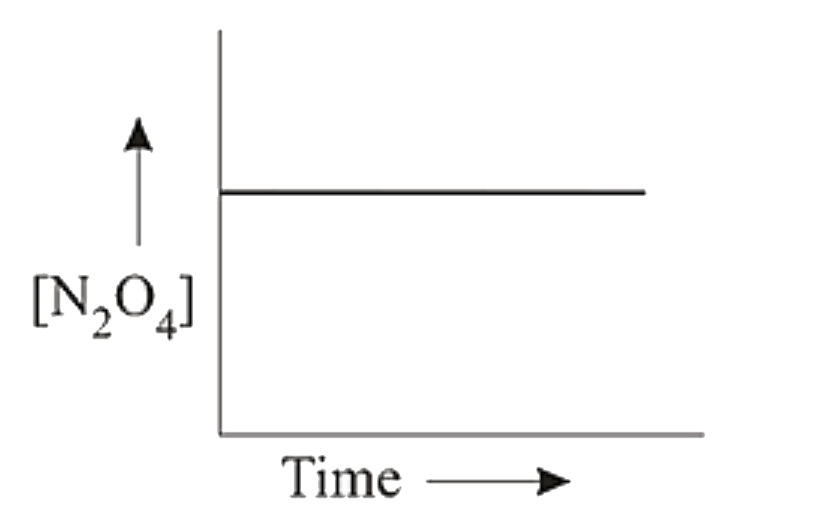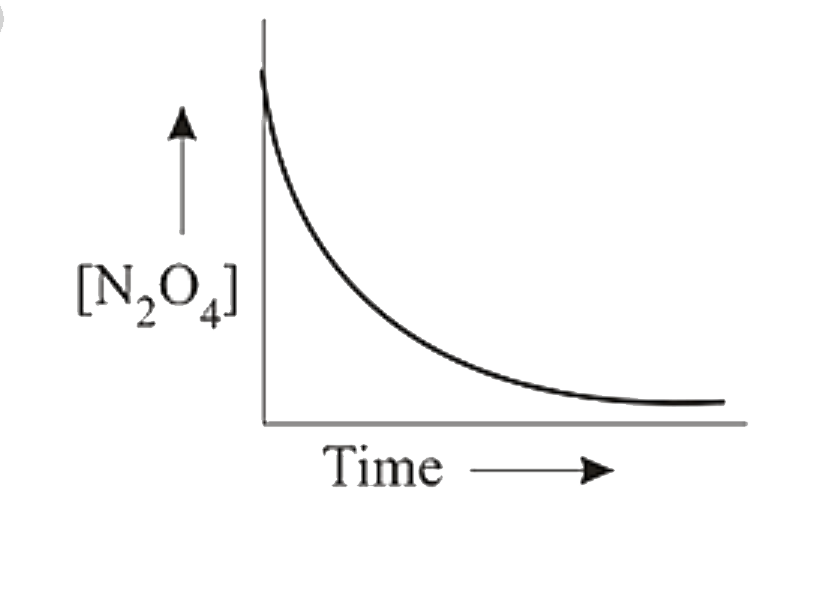The reaction , N2O4(g)→2NO2(g) , is first order reaction , which of the following best describes the variation of concentration of N2O4 with time ?




The correct Answer is:D
To solve the problem regarding the variation of concentration of N2O4 with time in the reaction N2O4(g)→2NO2(g), we need to analyze the characteristics of a first-order reaction.
1. Identify the Reaction Order:
The reaction given is a first-order reaction. This means that the rate of the reaction is directly proportional to the concentration of the reactant N2O4.
2. Write the Rate Law:
For a first-order reaction, the rate law can be expressed as:
Rate=k(N2O4)
where k is the rate constant and (N2O4) is the concentration of the reactant.
3. Use the Integrated Rate Equation:
The integrated rate equation for a first-order reaction is given by:
ln((N2O4)0(N2O4))=kt
where (N2O4)0 is the initial concentration at time t=0 and (N2O4) is the concentration at time t.
4. Analyze the Equation:
From the integrated rate equation, as time t increases, the natural logarithm of the ratio of the initial concentration to the current concentration increases. This indicates that the concentration of N2O4 decreases over time.
5. Exponential Decay:
The concentration of N2O4 decreases exponentially with time. This means that the graph of concentration versus time will show a downward curve that approaches zero but never actually reaches it.
6. Conclusion:
Therefore, the variation of concentration of N2O4 with time can be best described as decreasing exponentially.
Final Answer:
The concentration of N2O4 decreases exponentially with time.
---
The reaction given is a first-order reaction. This means that the rate of the reaction is directly proportional to the concentration of the reactant N2O4.
For a first-order reaction, the rate law can be expressed as:
Rate=k(N2O4)
where k is the rate constant and (N2O4) is the concentration of the reactant.
The integrated rate equation for a first-order reaction is given by:
ln((N2O4)0(N2O4))=kt
where (N2O4)0 is the initial concentration at time t=0 and (N2O4) is the concentration at time t.
From the integrated rate equation, as time t increases, the natural logarithm of the ratio of the initial concentration to the current concentration increases. This indicates that the concentration of N2O4 decreases over time.
The concentration of N2O4 decreases exponentially with time. This means that the graph of concentration versus time will show a downward curve that approaches zero but never actually reaches it.
Therefore, the variation of concentration of N2O4 with time can be best described as decreasing exponentially.
The concentration of N2O4 decreases exponentially with time.
Similar Questions
The reaction 2N2O5(g)→4NO2(g) is first order w.r.t. N2O5. Which of the following graphs would yield a straight line?
View SolutionConsider the following equilibrium
N2O4(g)⇔2NO2(g)
Then the select the correct graph , which shows the variation in concentrations of N2O4 against concentrations of NO2:
View Solution
Knowledge Check
For a reaction, 2N2O5(g)→4NO2(g)+O2(g) rate of reaction is:
ARate =−d[N2O5]dt=−14d[NO2]dt=12d[O2]dtBRate =−12d[n2O5]dt=14d[NO2]dt=d[O2]2CRate =−14d[N2O5]dt=12d[NO2]dt=d[O2]dtDRate =−12d[N2O5]dt=12d[NO2]dt=12d[O2]dt
For the reaction 4NO2(g)+O2(g)⇔2N2O5(g), which of the following facts holds good ?
View SolutionFor the reaction
N2(g)+3H2(g)→2NH2(g)
Which of the following is correct?
View SolutionFor the gaseous reaction: N2O4→2NO2
View SolutionFor the reaction N2O4(g)⇔2NO2(g), which of the following factors will have no effect on the value of equilibrium constant?
View SolutionFor the reaction,
N2O4(g)⇔2NO2(g)
the reaction connecting the degree of dissociation (α) of N2O4(g) with eqilibrium constant Kp is
where Pτ is the total equilibrium pressure.
View SolutionConisder the chemical reaction
N2(g)+3H2(g)→2NH3(g)
The rate of this reaction can be expressed in terms of time derivatives of the concentration of N2(g),H2(g), or NH3(g). Identify the correct relationship among the rate expresisons.
View SolutionThe rate constant k, for the reaction N2O5(g)→2NO2(g)+12O2(g) is 2.3×10−2s−1. Which equation given below describes the change of [N2O5] with time ? [N2O5]0 and [N2O5]t correspond to concentration of N2O5 initially and at time, t ?
View Solution
